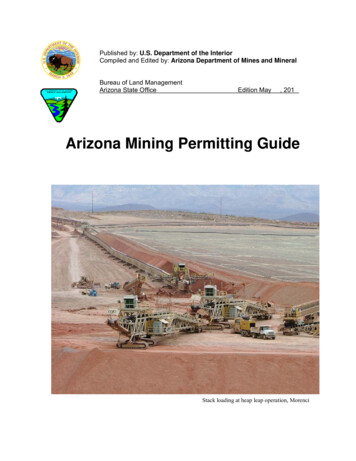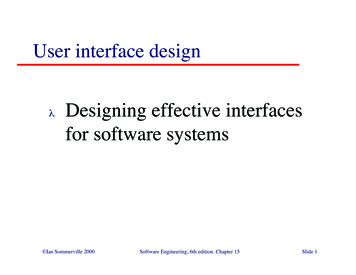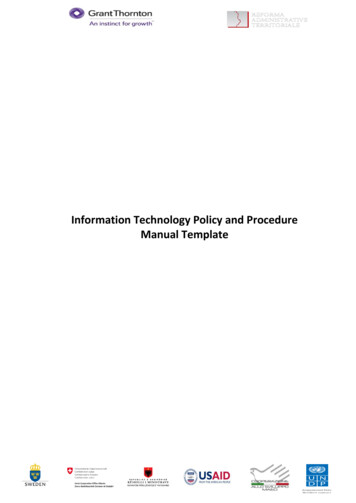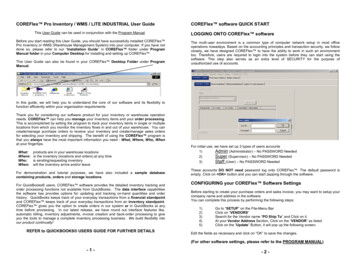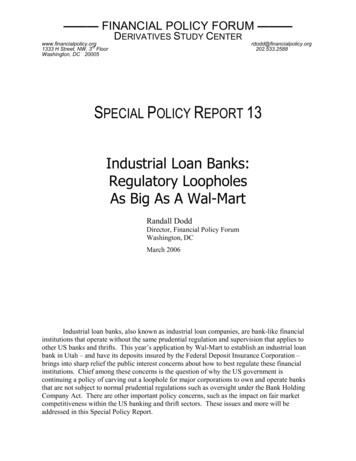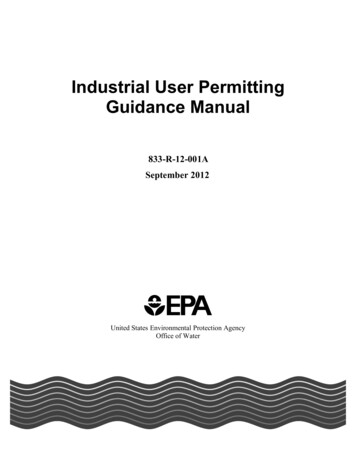
Transcription
Industrial User PermittingGuidance Manual833-R-12-001ASeptember 2012United States Environmental Protection AgencyOffice of Water
This page intentionally left blank.
DISCLAIMERThe discussion in this document is intended solely as a summary of existing guidance. Thisdocument is not a regulation, nor does it substitute for any requirements under the Clean WaterAct (CWA) or U.S. Environmental Protection Agency’s (EPA’s) regulations. Thus, it does notimpose legally binding requirements on EPA, states, municipalities, or the regulated community. Thegeneral descriptions provided in this document might not apply to a particular situation based on thecircumstances. This document does not confer legal rights or impose legal obligations on any member ofthe public.Among other things, the document describes existing requirements with respect to industrial dischargersand publicly owned treatment works (POTWs) under the CWA and its implementing regulations at Title40 of the Code of Federal Regulations, Parts 122, 123, 124, and 403 and chapter I, subchapter N.Although EPA has made every effort to ensure the accuracy of the discussion in this document, adischarger’s obligations are determined, in the case of directly discharging POTWs, by the terms of itsNational Pollutant Discharge Elimination System permit and EPA’s regulations or, in the case of indirectdischargers, by permits or equivalent control mechanisms issued to POTW industrial users or byregulatory requirements. Nothing in this document changes any statutory or regulatory requirement. If aconflict arises between this document’s content and any permit or regulation, the permit or regulationwould be controlling. EPA and local decision makers retain the discretion to adopt approaches on a caseby-case basis that differ from those described in this document where appropriate and authorized by EPAregulations, state law, or local ordinances.Mention of trade names or commercial products does not constitute endorsement or recommendation fortheir use.This document is current as of September 2012. EPA may decide to revise this document without publicnotice to reflect changes in the Agency’s approach to implementing pretreatment standards or to clarifyand update text. To determine whether EPA has revised or supplemented the information in thisdocument, access the document at http://www.epa.gov/npdes/pretreatment.
This page intentionally left blank.
CONTENTSCONTENTSPagePART I ESTABLISHING A PERMIT PROGRAM . ICHAPTER 1. BACKGROUND . 1-11.1 PRETREATMENT PROGRAM DEVELOPMENT . 1-31.2 INDIVIDUAL PERMITS OR GENERAL CONTROL MECHANISMS . 1-41.3 WHO ISSUES PERMITS . 1-51.3 WHY PERMITS ARE RECOMMENDED . 1-6CHAPTER 2. PERMIT ISSUANCE PROCESS . 2-12.1 HOW TO IDENTIFY INDUSTRIAL USERS . 2-12.2 WHO NEEDS A PERMIT . 2-22.3 WHEN TO ISSUE A PERMIT . 2-42.4 WHAT TYPES OF PERMITS TO USE . 2-52.4.1Individual Control Mechanisms . 2-52.4.2General Control Mechanisms . 2-62.5 PERMIT DURATIONS . 2-72.6 WHEN TO MODIFY OR TERMINATE PERMITS . 2-72.6.1Permit Modifications. 2-72.6.2Permit or Discharge Terminations or Suspensions . 2-92.7 PERMIT TRANSFERABILITY . 2-92.7.1Change in Ownership . 2-102.7.2Modify or Revoke and Reissue . 2-102.8 PUBLIC PARTICIPATION . 2-112.9 ISSUING THE FINAL PERMIT . 2-122.10 PERMIT APPEALS . 2-152.11 PERMIT REISSUANCE . 2-162.12 CONTINUING PERMITS BEYOND THEIR EXPIRATION DATE . 2-16CHAPTER 3. LEGAL AUTHORITY FOR A PERMIT PROGRAM . 3-13.1 LEGAL AUTHORITY . 3-13.1.1Authority Over All Industrial Users Contributing to the POTW . 3-23.1.2Authority to Require and Issue Individual Permits and General Control Mechanisms. 3-33.1.3Authority to Enforce Permit Violations . 3-6PART II PERMIT WRITING PROCEDURES . IICHAPTER 4. PERMIT APPLICATIONS . 4-14.1 WHAT INFORMATION TO COLLECT AND HOW TO COLLECT IT . 4-14.2 APPLICATION REVIEW PROCESS . 4-24.2.1Completeness . 4-24.2.2Accuracy . 4-54.2.3Background Information Review . 4-74.2.4Facility Inspection . 4-94.3 PUBLIC ACCESS TO INFORMATION . 4-10CHAPTER 5. PERMITTING CONSIDERATIONS . 5-15.1 CONTENTS OF A PERMIT . 5-1September 2012v
CONTENTS5.25.35.45.5STRUCTURE AND WORDING . 5-1COMMON PERMITTING ERRORS AND OMISSIONS . 5-2FLEXIBILITY . 5-3DOCUMENTING PERMIT DECISIONS . 5-5CHAPTER 6. COMPONENTS OF THE COVER PAGE . 6-16.1 FORMAT . 6-16.2 ELEMENTS OF THE COVER PAGE . 6-1CHAPTER 7. EFFLUENT LIMITATIONS. 7-17.1 SELECTING POLLUTANTS TO BE REGULATED. 7-17.1.1Which Pollutants Require Regulation? . 7-17.2 APPLYING EFFLUENT LIMITS . 7-177.2.1What Other Pollutants Are Present?. 7-187.2.2Relationship of Local Limits to Categorical Pretreatment Standards . 7-187.2.3Concentration- or Mass-Based Limits. 7-207.2.4NSCIU Requirements . 7-227.2.5Zero-Discharge Requirements . 7-227.2.6Tiered Permits . 7-23CHAPTER 8. MONITORING AND REPORTING REQUIREMENTS . 8-18.1 SAMPLING LOCATIONS . 8-38.2 POLLUTANTS TO BE MONITORED . 8-68.3 SAMPLE TYPE . 8-78.3.1Grab Sample. 8-78.3.2Composite Sample . 8-88.4 MONITORING FREQUENCIES . 8-88.5 ANALYTICAL METHODS . 8-128.6 REPORTING REQUIREMENTS . 8-128.6.1What Types of Information . 8-218.6.2When Reports Should be Submitted . 8-238.6.3Who Signs the Reports . 8-248.6.4Where Reports Are to be Sent . 8-258.6.5How Reports May be Submitted . 8-25CHAPTER 9. STANDARD CONDITIONS . 9-1CHAPTER 10. SPECIAL CONDITIONS . 10-110.1 COMPLIANCE SCHEDULES . 10-110.2 ADDITIONAL MONITORING REQUIREMENTS . 10-310.3 SPECIAL CONDITIONS FOR ZERO-DISCHARGE PERMITS . 10-4CHAPTER 11. DOCUMENTATION OF PERMIT DECISIONS . 11-111.1 PERMIT FACT SHEET . 11-211.2 PERMIT RECORD . 11-3PART III OVERVIEW OF REQUIREMENTS REGARDING POTW RECEIPT OF HAZARDOUS WASTES . IIICHAPTER 12. OVERVIEW OF REQUIREMENTS REGARDING POTW RECEIPT OF HAZARDOUSWASTES . 12-1viSeptember 2012
CONTENTSFIGURESFIGURE 2-1. COMMON ELEMENTS OF AN INDIVIDUAL PERMIT ISSUANCE PROCESS .2-14TABLESTABLE 4-1 EXAMPLES OF DEFICIENCIES COMMONLY FOUND IN PERMIT APPLICATIONS .4-3TABLE 4-2 COMMON INACCURACIES IN PERMIT APPLICATIONS .4-6TABLE 4-3 VERIFICATION OF FLOW DATA USING WATER BALANCE .4-7TABLE 5-1 EXAMPLE OF FLEXIBILITY OF INDIVIDUAL PERMITS .5-3TABLE 5-2 USING GENERAL CONTROL MECHANISMS .5-4TABLE 7-1 EXAMPLES OF SELECTING POLLUTANTS FOR REGULATION .7-2TABLE 7-2 FORMULAS FOR CALCULATING EQUIVALENT LIMITS FROM PRODUCTIONBASED STANDARDS .7-5TABLE 7-3 EXAMPLE OF INCORPORATING PRODUCTION-BASED STANDARDS ASEQUIVALENT MASS LIMITS IN A PERMIT .7-6TABLE 7-4 NATIONAL PROHIBITED DISCHARGES .7-11TABLE 7-5 EXAMPLE OF INCORPORATING PROHIBITED DISCHARGES IN PERMIT .7-12TABLE 7-6 EXAMPLE OF FACT SHEET DOCUMENTING THE DETERMINATION OF THE MOSTSTRINGENT DAILY MAXIMUM EFFLUENT LIMITS.7-19TABLE 7-7 FORMULAS FOR CONVERTING LOCAL LIMITS .7-21TABLE 8-1 EXAMPLES OF SPECIAL MONITORING AND REPORTING REQUIREMENTS FORSPECIFIC CATEGORICAL PRETREATMENT STANDARDS .8-2TABLE 8-2 EXAMPLES OF SPECIFYING SAMPLING LOCATIONS IN PERMITS .8-5TABLE 8-3 RECOMMENDED INDUSTRIAL SELF-MONITORING FREQUENCIES DURING THEINITIAL COMPLIANCE PERIOD .8-10TABLE 8-4 INDUSTRIAL USER REPORTING REQUIREMENTS .8-14TABLE 8-5 EXAMPLE OF REPORTING REQUIREMENTS IN A PERMIT.8-19TABLE 8-6 FUNDAMENTAL ELEMENTS OF AN INDUSTRIAL USER PERIODIC COMPLIANCEREPORT .8-21TABLE 9-1 EXAMPLES OF DIFFERENT LANGUAGE USED TO INCORPORATE STANDARDCONDITIONS INTO INDUSTRIAL USER PERMITS .9-1TABLE 10-1 EXAMPLE OF INCORPORATING A COMPLIANCE SCHEDULE IN THE SPECIALCONDITION SECTION OF A PERMIT .10-2TABLE 10-2 EXAMPLES OF INCORPORATING ADDITIONAL MONITORING REQUIREMENTSIN PERMITS.10-3TABLE 11-1 COMPONENTS OF A PERMIT FACT SHEET .11-2September 2012vii
CONTENTSAPPENDICESAPPENDIX A BIBLIOGRAPHYAPPENDIX B GLOSSARY OF TERMSAPPENDIX C SAMPLE PERMIT APPLICATION FORMAPPENDIX D PERMIT FACT SHEET TEMPLATEAPPENDIX E SAMPLE PERMIT FACT SHEET AND INDUSTRIAL USER PERMITAPPENDIX F SAMPLE STANDARD CONDITIONS FOR PERMITSAPPENDIX G SUMMARY OF INDUSTRIAL SECTORS WITH CATEGORICAL PRETREATMENTSTANDARDS AND REQUIREMENTSAPPENDIX H PRETREATMENT STREAMLINING RULE FACT SHEET 7.0: BESTMANAGEMENT PRACTICESAPPENDIX IPRODUCTION-BASED STANDARDS FACT SHEETAPPENDIX J COMBINED WASTESTREAM FORMULA FACT SHEETviiiSeptember 2012
HOW TO USE THIS MANUALHOW TO USE THIS MANUALPURPOSEThe U.S. Environmental Protection Agency (EPA), Office of Water, prepared this guidance manual toprovide information guidance for developing and issuing permits (or control mechanisms) to nondomestic(Industrial) Users under the National Pretreatment Program. The purpose of this guidance is to assist newpermit writers, experienced permit writers, and legal and administrative personnel who are involved inimplementing an SIU permitting program in preparing effective and enforceable permits or other controlmechanisms.This manual provides documentation of EPA’s recommendations as well as federal requirements forSignificant Industrial User (SIU) permit contents and structure. The manual contains many examples ofsections and conditions of a permit, as well as complete sample permits and fact sheets. The goal is tofurnish this information to permit writers in a reference manual format that they can use throughout thepermitting process.In addition to the people directly responsible for drafting and issuing permits, legal and administrativesupport staff should be aware of several aspects of the permitting process. For such individuals, themanual provides background information on requirements of the issuance process and discusses thenecessary legal authority required to implement an effective program.USEIt is recommended that all personnel directly involved with the permit drafting and issuance processesscan the entire manual to get an overview of its contents and structure. In scanning the manual, the readershould note any sections that are pertinent to the reader’s role in the permitting process.EPA recommends that new permit writers read all sections of this manual carefully to learn about eachphase of the permit drafting and issuance process. An understanding of each section will provide theinexperienced permit writer with an overview of the typical components of an SIU permit and the permitissuance process including legal requirements, permit drafting, public participation, and permit issuance.Experienced permit writers should carefully study the permitting examples provided to determine if theirown permits could be strengthened by modifying or adding the recommended provisions. The manual canalso be used as a reference source.September 2012ix
HOW TO USE THIS MANUALThe Control Authority’s legal and administrative support personnel should also become familiar with theprovisions of the guidance manual with which they will be involved. Such individuals should carefullyread the background and issuance procedures sections to ensure that their administrative procedures andlegal authority are consistent with applicable requirements. The glossary in Appendix B and the list ofacronyms and abbreviations immediately following this section are provided to assist the reader. Whenterms appear that are unfamiliar, the reader should consult the glossary and list of acronyms andabbreviations.Finally, the regulated community and public citizens might also be interested in this manual to learn aboutthe legal and technical aspects of issuing industrial user permits.LIMITATIONSWhile this guidance manual gives an overview of the permit writing and issuance processes, it is notintended to address all the specific questions that could arise during the permitting process. Where otherpertinent guidance is available, this manual references those documents. The permit writer is, therefore,encouraged to use this manual in conjunction with the following EPA guidance documents: Local Limits Development Guidance Guidance for Developing Control Authority Enforcement Response Plans Guidance Manual for the Control of Wastes Hauled to Publicly Owned Treatment Works Industrial User Inspection and Sampling Manual for POTWs Multijurisdictional Pretreatment Programs Guidance Manual Pretreatment Streamlining Rule Fact Sheet 7.0: Best Management Practices (EPA-833-F-06-013)Those documents serve as companion documents to this manual and contain technical guidance ondeveloping local limits, specific information on enforcing Pretreatment Standards and Requirements,guidance for controlling hauled waste, information regarding compliance inspections and sampling,guidance on implementing a pretreatment program within multiple jurisdictions, and informationregarding best management practices.Throughout the text of this manual, all references to supplementary guidance material and developmentdocuments cite only the document title. Complete citations for all relevant guidance documents are foundin the bibliography in Appendix A. Any reference to the Code of Federal Regulations (CFR) is followedxSeptember 2012
HOW TO USE THIS MANUALby a bracketed citation of the specific section (e.g., [40 CFR Part 403]). References to the FederalRegister are also bracketed (e.g., [53 FR Part 40562; October 17, 1988]).In general, each Control Authority has pretreatment concerns unique to its own area, necessitatingspecific local requirements. Discussion of specific requirements that must be met to comply with local orstate laws under which a Control Authority operates is beyond the scope of this document. The permitwriter should, therefore, consult with his/her attorney on such issues.The National Pretreatment Program continues to evolve, and the concepts and procedures recommendedhere could change with time and experience. For notifications on updates to the National PretreatmentProgram, see EPA’s website (www.epa.gov/npdes/pretreatment).September 2012xi
HOW TO USE THIS MANUALThis page intentionally left blank.xiiSeptember 2012
ACRONYMS AND ABBREVIATIONSACRONYMS AND ABBREVIATIONSThe following is an alphabetical list of all acronyms and abbreviations used in this manual. Its purpose isto serve as a quick reference for those who might be unfamiliar with the lettered shortcuts that arecommonly used to signify terms and phrases associated with the industrial pretreatment permittingprogram.BMPsBest Management PracticesBMRBaseline Monitoring ReportBODBiochemical Oxygen DemandBPJBest Professional JudgmentCFRCode of Federal RegulationsCIUCategorical Industrial UserCWAClean Water Act (Public Law 95-217 as amended)CWFCombined Wastestream FormulaEPAU.S. Environmental Protection AgencyFRFederal RegisterGCGas ChromatographyGC/MSGas Chromatography/Mass SpectroscopygpdGallons Per DayLELLower Explosive LimitMAHLMaximum Allowable Headworks LoadingmgdMillion Gallons Per Daymg/LMilligrams Per LiterSeptember 2012xiii
ACRONYMS AND ABBREVIATIONSMTCIUMiddle-tier Categorical Industrial UserNAICSNorth American Industry Classification SystemNPDES permitNational Pollutant Discharge Elimination System permit issued pursuant to section402 of the Clean Water ActNSCIUNonsignificant Categorical Industrial UserO&MOperation and MaintenancePOTWPublicly Owned Treatment WorksPSESPretreatment Standards for Existing SourcesPSNSPretreatment Standards for New SourcesQAQuality AssuranceQCQuality ControlRCRAResource Conservation and Recovery ActSICStandard Industrial ClassificationSIUSignificant Industrial UserSWDASolid Waste Disposal ActTOMPToxic Organic Management PlanTSSTotal Suspended SolidsTSDFTreatment, Storage, and Disposal FacilityTTOTotal Toxic OrganicsxivSeptember 2012
PART IEstablishing a Permit Program
This page intentionally left blank.
CHAPTER 1BackgroundCHAPTER 1.BACKGROUNDThe National Pretreatment Program’s primary goal is to protect Publicly Owned Treatment Works(POTWs) and the environment from adverse impacts that might occur when pollutants are discharged intoa sewage system.The specific pretreatment program goals are as follows: Prevent the introduction of pollutants into the POTW that will pass through the treatment worksor are otherwise incompatible with treatment Prevent the introduction of pollutants that could interfere with POTW operations, includinginterference with the POTW’s chosen sewage sludge use and disposal practices, as well aspollutants that could threaten worker health and safety Improve opportunities to recycle and reclaim municipal and industrial wastewaters and sludgesDischarges to a POTW have the potential to cause the POTW to violate its National Pollutant DischargeElimination System (NPDES) permit if the treatment system is not able to adequately remove thepollutant contained in the discharge or the pollutant otherwise damages or disrupts operations of thePOTW. Industrial discharges to POTWs have historically been a significant source of pollutants in ournation’s waters. Certain industrial discharges can interfere with the operation of POTWs, leading to thedischarge of untreated or inadequately treated wastewater into rivers, lakes, and such. Some pollutants arenot compatible with biological wastewater treatment at POTWs and may pass through the treatment plantuntreated. This pass through of pollutants affects the surrounding environment, occasionally causing fishkills or other detrimental alterations of the receiving waters. Even when POTWs have the capability toremove toxic pollutants from wastewater, the toxics can end up in the POTW’s sewage sludge, which inmany places is land applied to food crops, parks, or golf courses as fertilizer or soil conditioner.The Clean Water Act (CWA or the Act) addresses this problem by requiring the U.S. EnvironmentalProtection Agency (EPA) to promulgate federal standards for the pretreatment of wastewater dischargedto a POTW [33 U.S.C. § 1317(b)(3)]. Section 307(d) of the Act prohibits discharge in violation of anypretreatment standard [33 U.S.C. § 1317(d)]. The CWA prohibits the introduction of pollutants into aPOTW that might pass through or interfere with the POTW and its operations. Discharge of a pollutant isa term specifically defined in the CWA to mean the discharge of a pollutant to navigable waters, and suchdischarges are generally prohibited except in compliance with the Act and a permit under section 402 ofAugust 20091-1
CHAPTER 1Backgroundthe Act. While this document uses the word discharge in its commonly understood meaning whenreferring to the introduction of pollutants into a POTW, such a discharge is not a CWA discharge ofpollutants to navigable waters.To address indirect discharges from industries to POTWs, EPA has established the National PretreatmentProgram as a component of the NPDES Permitting Program. The National Pretreatment Program requiresindustrial and commercial dischargers to treat or control pollutants in their wastewater before discharge toPOTWs. EPA has chosen to promulgate pretreatment standards at the same time it promulgates effluentlimitations guidelines for industry categories of direct dischargers under sections 301(b) and 304(b) of theAct [33 U.S.C. § 1311(b) and 1314(b)]. These pretreatment regulations are applicable to industrialindirect dischargers—those discharging to POTWs—and are known as categorical pretreatmentstandards. EPA has also developed other nationally applicable pretreatment standards (nationalpretreatment standards) under section 307(b) in its General Pretreatment Regulations for Existing andNew Sources of Pollution (Pretreatment Regulations) at 40 CFR Part 403. Such pretreatment standardsare applicable to any user of a POTW, defined as a source of an indirect discharge [40 CFR 403.3(i)].These national pretreatment standards include (1) a general prohibition and (2) specific prohibitions. Thegeneral prohibition prohibits any user of a POTW from introducing a pollutant into the POTW that willcause pass through or interference. EPA’s regulations define both pass through and interference. Passthrough is defined as a discharge that exits the POTW into waters of the United States in quantities orconcentrations that, alone or in conjunction with a discharge or discharges from other sources, is a causeof a violation of any requirement of the POTW’s NPDES permit. Interference includes a discharge that,alone or in conjunction with a discharge from other sources will, among other things, prevent sewagesludge use in compliance with described regulatory provisions including section 405 of the Act [40 CFR403.3(k)(2)]. In addition, under the Pretreatment Regulations, certain POTWs must develop and enforcelocal limits to implement the general and specific prohibitions of section 403.5(a)(1) and (b). Local limitsthat are deve
Industrial User Permitting Guidance Manual 833-R-12-001A September 2012 United States


